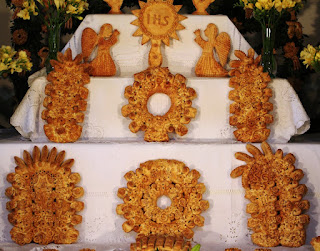This is the proposal I send out to Italian-American cultural groups to interest them in my presentations. I gave a presentation to an Italian Language club in May at Our Lady of Grace Church in Gravesend, Brooklyn. I'm returning to their group in September to talk about another passion: Regional Italian Cuisine.
FESTA, FAMILY AND FOOD
The Origins & Traditions of Three Italian Festivals
A
Fulbright Project
by
Stephanie Trudeau
About the Presentation:
This presentation is
an examination of the evolution and continuity of the cultural traditions of
three saints’ feasts, the Gigli in Nola, the Ceri in Gubbio and St. Joseph’s
feast in Salemi, Sicily. These festivals unite their communities in creative,
cooperative effort toward a common goal and the feasts’ artwork, music and
celebratory foods illustrate and symbolize their historical tales of heroic
sacrifice and redemption. The enduring strength of these feasts may be because
they reinforce the pride and identity of the citizens of communities so
impoverished in the past that it gave impetus to the Italian diaspora of the
late 19th century. The feasts celebrate suffering, rejoicing and survival, and
their folk art serves to reshape historical narratives and social identities in
a modern society. This nine-month research project examined the evolution of
these feasts from pagan rites to Christian celebrations, their artwork
combining contemporary design with the baroque, all serving as expressions of
cultural identity.
The photographs and commentary bring to life the elements of the feasts’ preparations and celebrations:
·
Women and their
daughters make bread, crafted in myriad shapes and forms, as the principal
element used to decorate the altars and banquet tables created for St. Joseph’s
feast.
·
Papier-mâché is the
art form used to create ornately sculpted facades for the 85-foot towers -
the gigli - carried on the shoulders of men through the
streets of Nola to celebrate the Festa dei Gigli.
·
The Ceri is
a race through the streets of Gubbio of three huge wooden cylinders, each
crowned with a statue of a saint and also borne on the shoulders of a nine-man
team. Men and their sons carry on the traditions of both the Gigli and
the Ceri.
The duration of the presentation is about 45 minutes with a half-hour Q&A period.
About the Presenter:
Stephanie Trudeau is a
singer/actress/writer who worked nine years as a music educator at several
Catholic elementary schools in Brooklyn. After completing her B.S. in 2005 on
the History and Performance of American Popular Song, she began a research
project on the continuity of Italian culture and traditions in Italian-American
communities. In 2006 she was awarded a Fulbright Scholarship to Italy to
continue her Festa research, in which she compared and contrasted the
traditions of the feasts as they are celebrated in both Italy and the U.S.
After completing her Fulbright she began working at The Bronx Museum of the
Arts as manager of the museum book/gift shop. After leaving the Bronx Museum
Stephanie created a company, Stevie’s Artisans Urban Folk Art, which sells the
work of four artisans. She has presented her Festa photos at DeVry College in
New Jersey, The Brooklyn Historical Society and The Italian American Historical
Society of Providence, RI. Her article, Born to Giglio, published
in 2005 in “Voices, The Journal of New York Folklore,” was the start of this
Festa journey.
The following introduction was used by the Italian American Museum for a recent speaking engagement: The Italian American Museum invites you to a photo presentation of a Fulbright project entitled, "Festa, Family and Food." Please join us as Fulbright scholar Stephanie Trudeau presents a lecture with power point presentation on the history and cultural significance of three saints’ festivals celebrated in Italy and in Italian-American communities.


















































